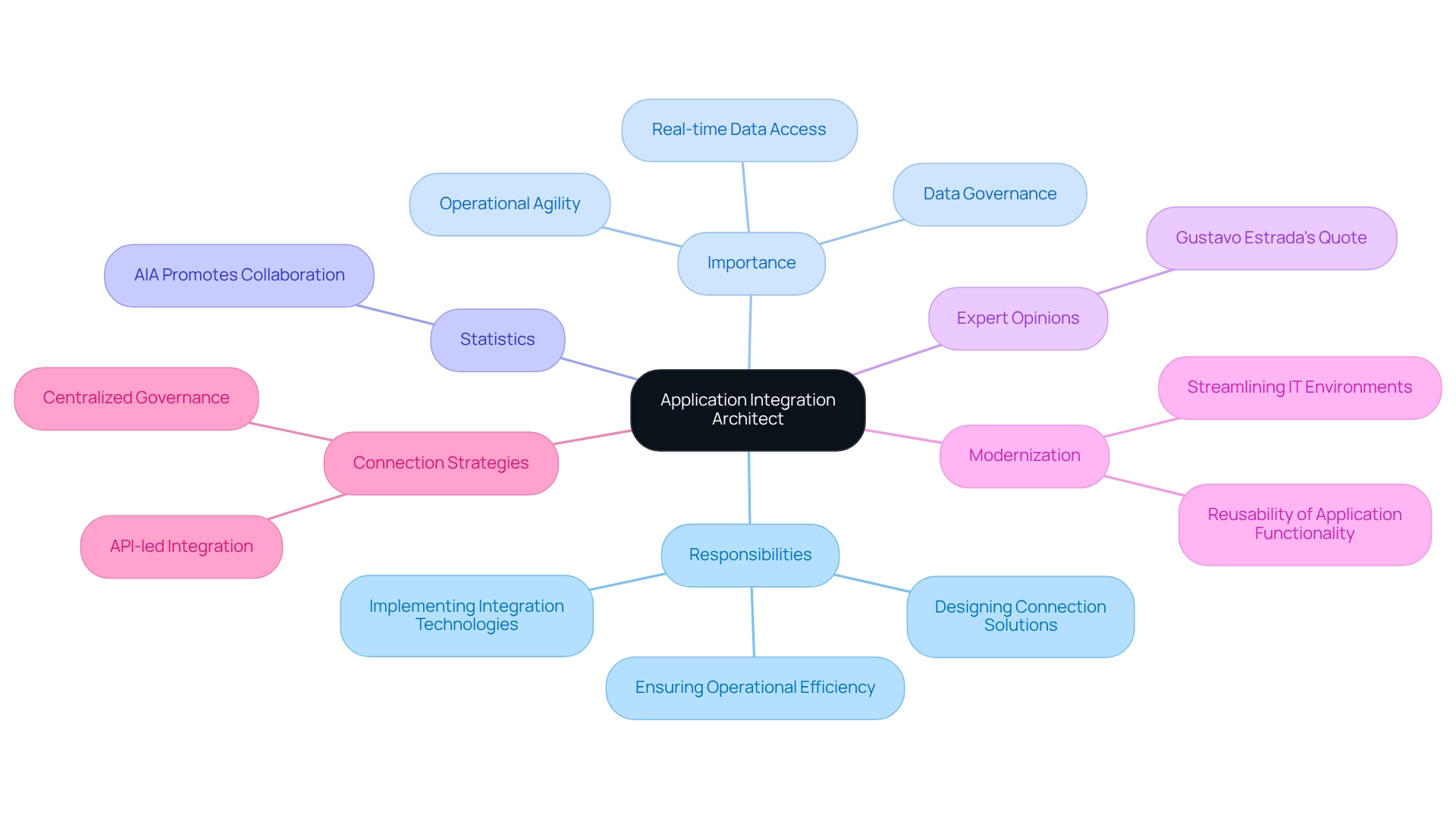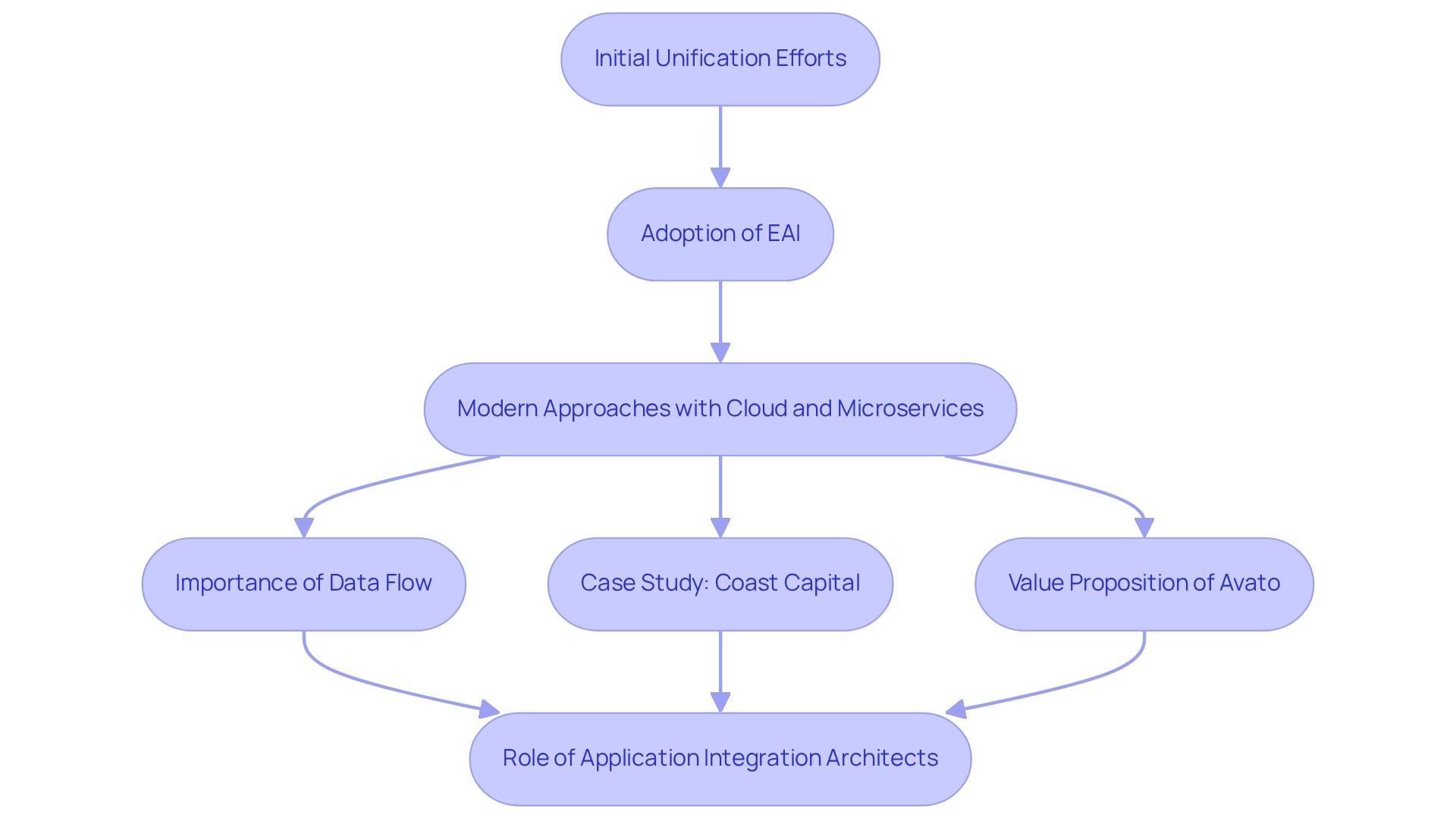Overview
The role of an application integration architect is pivotal in designing and implementing solutions that facilitate seamless communication between diverse software systems, enhancing our operational efficiency and data management. We recognize that this role has evolved significantly to address the complexities of modern IT environments. It now requires a blend of technical proficiency, architectural design skills, and effective communication to align integration strategies with our business objectives.
What’s holding your team back from achieving optimal integration? By leveraging the expertise of an application integration architect, we can navigate these challenges together, ensuring that our integration strategies not only meet technical requirements but also drive business success.
Introduction
In today’s landscape, increasingly defined by digital transformation, we recognize the Application Integration Architect as a cornerstone for organizations striving for operational excellence. These skilled professionals bear the critical responsibility of designing integration solutions that enable disparate software systems to communicate seamlessly, fostering a cohesive architecture that enhances data exchange and process integration.
As we navigate complex IT landscapes filled with cloud computing and microservices, the demand for architects who can effectively bridge the gap between technology and business needs has never been greater. Their expertise not only streamlines operations but also ensures data governance and integrity, making them indispensable in today’s fast-paced environment.
With the right blend of technical proficiency and strategic insight, we see Application Integration Architects as key players in driving innovation and agility within organizations.
What’s holding your team back from realizing this potential?
Define Application Integration Architect
An application integration architect is a specialized IT expert tasked with designing and implementing connection solutions that enable diverse software systems to communicate effortlessly. The application integration architect plays a crucial role in establishing a unified architecture that enables data exchange and process coordination across different applications, ensuring operational efficiency and effectiveness. We understand that the application integration architect must possess a deep understanding of both the technical aspects of integration technologies and the business needs of the organization, effectively bridging the gap between IT and business objectives.
The significance of this role is underscored by current statistics showing that Architecture for Connecting Systems (AIA) promotes collaboration by allowing real-time access to shared data and resources. This capability is essential in today’s fast-paced business environment, where timely data access can significantly impact decision-making and operational agility.
Furthermore, expert opinions emphasize that the role of an application integration architect is becoming increasingly essential as organizations aim to modernize their IT environments. Successful unification solutions crafted by these architects not only streamline processes but also enhance data governance and management. For instance, centralized governance is crucial for ensuring data accuracy, integrity, and security, and AIA promotes defining clear rules for data flow, which reduces duplication and errors, thereby enhancing overall data quality. Architects focused on system connectivity also employ API-led approaches, utilizing standardized APIs for simpler management and upkeep of connections, which is essential for effective unification.
Gustavo Estrada, a client, stresses this notion by stating, “Avato has the capability to streamline complicated projects and provide outcomes within preferred timelines and budget limits,” underscoring the efficiency of Architects in accomplishing connection objectives through Avato’s Hybrid Platform.
Moreover, the potential reusability of application functionality is a key consideration when selecting a connection strategy, highlighting our role in modernizing IT environments. Case studies demonstrate the effectiveness of System Connection Architects in various sectors, showcasing our capability to simplify complex unification projects and achieve results within desired timelines and financial limits. As organizations persist in managing the complexities of digital transformation, the application integration architect’s role remains essential in attaining smooth connectivity and operational excellence.

Trace the Evolution of the Role
The role of the application integration architect has undergone a remarkable transformation over the past few decades. Initially, unification efforts were often improvised, focusing primarily on direct connections between varied systems. However, as we adopted increasingly intricate IT environments, the necessity for a more organized unification approach became evident. The rise of enterprise application integration (EAI) in the late 1990s and early 2000s marked a significant turning point, leading to the establishment of robust unification frameworks and middleware solutions.
In today’s environment, characterized by cloud computing, microservices, and API-driven architectures, we must skillfully navigate a complex landscape that demands flexibility and a comprehensive understanding of various unification patterns and technologies. This evolution underscores the critical importance of seamless data flow and interoperability in fostering business agility and driving innovation. As organizations seek to modernize their operations, our expertise as application integration architects becomes essential in ensuring that unification strategies align with overarching business objectives, ultimately enhancing performance and competitiveness.
Furthermore, with services guaranteeing round-the-clock availability for essential connections, the reliability of connection solutions has become vital. The hybrid platform has demonstrated its capability to manage intricate connections with efficiency and dependability, as evidenced by its successful deployment in financial institutions such as Coast Capital, where system transitions were executed with minimal downtime, including an impressive 63-second outage during a significant system switch in June 2016. This reliability is crucial for us as application integration architects, especially in sectors like banking, where system failures can lead to significant consequences.
Our company, founded on the ideals of commitment to streamlining connections, distinguishes itself through speed, security, and clarity in linking. The case study titled “Value Proposition of Avato” illustrates how we maximize the potential of legacy systems while maintaining a competitive edge. Additionally, Wietse Venema’s acknowledgment of the inevitability of software failure highlights the challenges faced by Architects of System Coordination, emphasizing the necessity for robust coordination strategies in intricate environments.

Identify Essential Skills and Qualifications
To excel as application integration architects, we recognize that several key skills and qualifications are essential.
-
Technical Proficiency is paramount. A comprehensive understanding of unification technologies, including APIs, middleware, and data transformation tools, is crucial. Familiarity with programming languages and frameworks commonly utilized in merging projects enhances our efficiency. Our hybrid unification platform supports these technologies, enabling us to streamline connection processes.
-
Architectural Design Skills are fundamental; the capability to create scalable and efficient connection architectures that align with business objectives is vital. This encompasses an understanding of unification patterns and best practices, which are essential for successful implementations. The structure is specifically crafted to facilitate architects in developing efficient solutions.
-
Analytical Thinking is necessary. Strong problem-solving skills enable us to identify integration challenges and develop effective solutions, ensuring that projects meet their goals. Our platform improves operational visibility, allowing us to swiftly identify and address problems as they occur.
-
Communication Skills are also critical; we must effectively convey complex technical concepts to non-technical stakeholders, fostering alignment between IT and business objectives. Involving stakeholders early in the process, as we recommend, guarantees that requirements are precisely captured from the beginning.
-
Project Management experience is advantageous. Overseeing combined projects, including planning, execution, and monitoring, ensures timely delivery and adherence to budget constraints. Our commitment to 24/7 uptime and secure transactions supports architects in maintaining project integrity and reliability.
-
Certifications in unification technologies or architecture frameworks can enhance credibility and demonstrate expertise in our field.
As we look to 2025, the demand for technical skills in unification architecture continues to rise, with a notable emphasis on proficiency in Software as a Service (SaaS) solutions and containerization technologies like Docker and Kubernetes. Recent statistics indicate that over 70% of organizations prioritize these skills to ensure compatibility and security in their unification efforts. Case studies highlight how proficient application integration architects have effectively guided intricate projects, underscoring the significance of these professionals in managing the challenges of contemporary IT settings and promoting successful unification efforts. Our robust technology foundation is essential for organizations seeking to modernize operations, minimizing risks and ensuring reliable integration, ultimately helping businesses maintain a competitive edge in their industries.

Conclusion
In today’s digital landscape, the role of the Application Integration Architect is undeniably crucial. Seamless communication between disparate systems is essential for operational success. By designing and implementing integration solutions, we enhance data exchange and ensure that organizations can adapt quickly to evolving business needs. Our expertise in both technical capabilities and strategic alignment with business objectives empowers organizations to navigate complex IT environments effectively.
As the demand for integration architects grows, so too does the need for a comprehensive skill set that encompasses technical proficiency, architectural design, analytical thinking, and effective communication. This multifaceted expertise is vital for developing integration strategies that drive innovation and maintain data integrity across systems. The evolution of this role, from ad-hoc connections to structured frameworks, highlights the importance of adaptability and reliability in integration solutions, especially in sectors where operational downtime can have significant repercussions.
Ultimately, organizations that prioritize the integration architect’s role stand to gain a competitive edge in the marketplace. By leveraging our skills to streamline processes and enhance data governance, businesses can achieve greater agility and operational excellence. Embracing the potential of Application Integration Architects is not just a strategic advantage; it is a necessary step toward thriving in an increasingly interconnected and fast-paced digital world.

